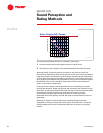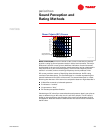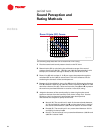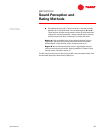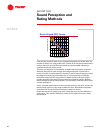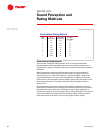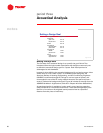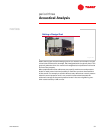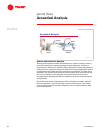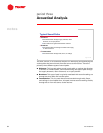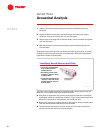
30 TRG-TRC007-EN
notes
period three
Acoustical Analysis
Setting a Design Goal
The first step of an acoustical design is to quantify the goal. Period Two
introduced several single-number descriptors that designers commonly use
to define the acoustical design goal for a space. Each descriptor has its
advantages its and drawbacks.
In general, when defining the acoustical design goal for an interior space, either
an NC value or an RC value is used. To aid HVAC system designers, the
American Society of Heating, Refrigerating, and Air-Conditioning Engineers
(ASHRAE) recommends target RC ratings for various types of spaces, and
encourages the use of the RC rating method whenever the space requires a
neutral, unobtrusive background sound. Figure 34 includes an excerpt from the
ASHRAE Handbook—Applications (Table 43 in Chapter 46 of the 1999 edition).
As mentioned earlier, A-weighting is also used in many hearing-protection
safety standards for industrial environments. These standards generally take
the form of a maximum A-weighted sound-pressure level at a specified
distance from the piece of machinery.
Setting a Design Goal
room type
hotels/motels
guest rooms
banquet rooms
libraries
office buildings
open plan offices
public lobbies
performing arts
theaters
practice rooms
schools
small classrooms
large classrooms
room type
hotels/motels
guest rooms
banquet rooms
libraries
office buildings
open plan offices
public lobbies
performing arts
theaters
practice rooms
schools
small classrooms
large classrooms
RC(N) criteria
25 to 35
25 to 35
30 to 40
30 to 40
40 to 45
25 max
35 max
40 max
35 max
RC(N) criteria
25 to 35
25 to 35
30 to 40
30 to 40
40 to 45
25 max
35 max
40 max
35 max
Figure 34



